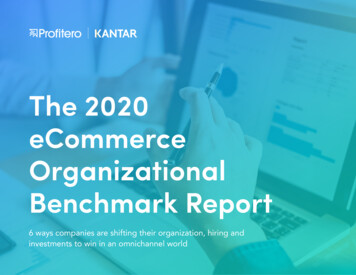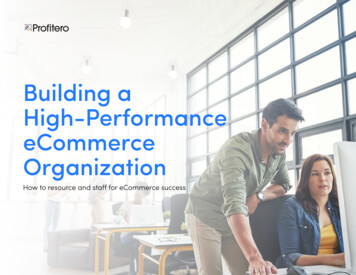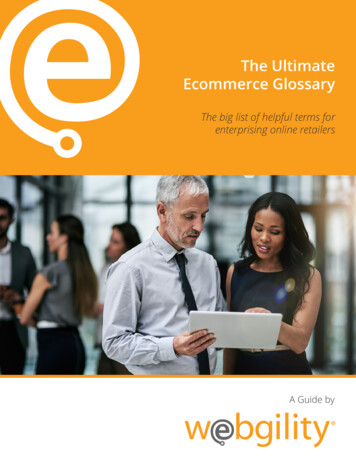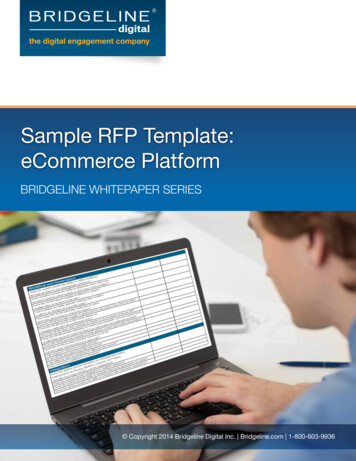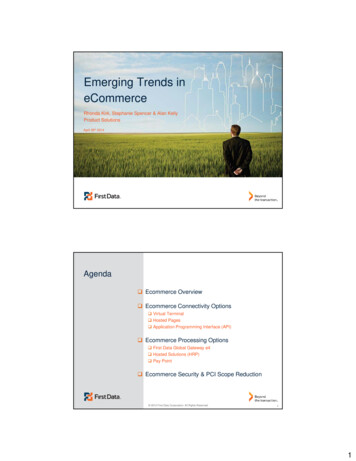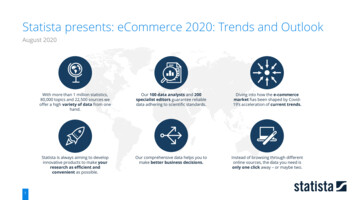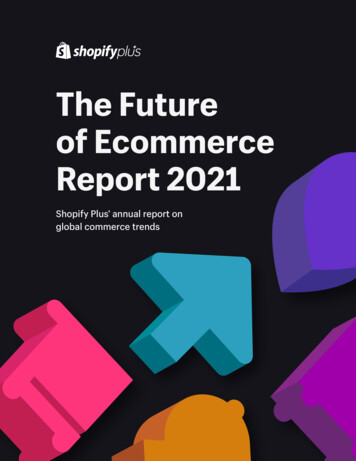
Transcription
The Futureof EcommerceReport 2021Shopify Plus’ annual report onglobal commerce trends
The Future of Ecommerce Report 2021The pandemic has left an enduring mark onthe consumer landscape. Years of changehave happened in weeks: Offline spendingshifted online. Products rarely boughtonline are now ecommerce staples. Andimmediacy, convenience, and speed aretop consumer demands.This is the new normal.The Future of Ecommerce Report 2021The future ofecommerce in 2021
The Future of Ecommerce Report 2021Ecommerce is at an all-time high. Lockdowns, travel bans, and retail closuresforced the consumer online, and the world’s largest retailers soon followed,in some cases selling direct to consumer (DTC) for the first time. But not allecommerce newcomers had the infrastructure in place to deliver a world-classcustomer experience.One way DTC brands are standing out in a crowded ecommerce space is throughautomated shipping and fulfillment. Orders must have fast, free, and sustainableshipping. And the unboxing video phenomenon has caused DTC companies toinvest in custom branded packaging.Executive summaryExecutive summaryTo better compete with marketplaces and retail giants, brands are also investingin richer, more personalized experiences. Humanizing their brand also aidsin customer retention, now a top priority as acquisition costs rise, along withuncertainty in digital advertising.3 / 67
The Future of Ecommerce Report 2021MethodologyThird-party data included in this report has been sourced from Statista, eMarketer, GlobalWeb Index, Google, IBM, Deloitte, Accenture, Gartner, McKinsey, Forrester, Nielsen, andthe World Trade Organization. Corporate data and consumer insights have been sourcedfrom the quarterly earnings calls of Walmart, Target, FedEx, UPS, Home Depot, Lowes,Shopify, Salesforce, Adobe, Microsoft, PayPal, Nvidia, and The Trade Desk.We conducted more than two dozen interviews to gather insight from industry leaders,investors, and subject matter experts. Prior to publication, the report was reviewed bythird parties with expertise in ecommerce, global trade, and consumer behavior.Trend 1Ecommerce boom fuels record online competitionDTC brands prioritize seamless omnichannel experience to win new customers.Trend 2New consumer behaviors reshape future of retailBrands build creative new digital experiences to unlock the future of retail.Trend 3Fulfillment emerges as competitive differentiatorConsumers gravitate to brands offering fast, free, sustainable shipping.Trend 4Brand building challenged by marketplace dominanceNew search and purchasing habits cause brands to personalize with a human touch.Trend 5Retention becomes a top priority as acquisition costs spikeBrands experiment with new channels as digital advertising uncertainty rises.MethodologyEach of our trends was born of data, reviewed by the best minds in commerce. The insightprovided is nuanced, region specific, and actionable. Our report is based on more thantwo dozen internal surveys of Shopify Plus merchants operating in the U.S., Canada, AsiaPacific, Europe, and the Middle East.
Trend 1Ecommerce boomfuels record onlinecompetitionDTC brands prioritize seamless omnichannelexperience to win new customers.Key takeawaysThough global ecommerce growth will slow before picking up in 2022, ecommerce salesare at an all-time high after the pandemic accelerated years of growth in just weeksRecord ecommerce competition—fueled by legacy wholesalers, global retail giants,and product categories not traditionally purchased online—is driving up customeracquisition costsMany new competitors are not equipped to compete on customer experience, a topdifferentiator online, giving an edge to brands with immersive omnichannel experiences
The Future of Ecommerce Report 2021: Trend 1Shoppers worldwide fuel ecommercesupercycleAt the height of the COVID-19 pandemic, 10 years of ecommerce growthhappened in just 90 days.Sourced from McKinseyAs countries locked down and retailers were forced to close, ecommerce reached an alltime high of 16.4% of total global retail sales. 1 It’s not just Gen Z and millennials driving thistrend—older shoppers have also moved online. 2 According to a global survey across 11markets by Shopify, 84% of consumers shopped online during the pandemic.3Ecommerce boom fuels record online competitionU.S. ecommerce penetration, %6 / 67
The Future of Ecommerce Report 2021: Trend 1If you're waiting for this to end, you say we'regonna be back to normal in two months,that we're just biding our time and gettingthrough it, then you're gonna be screwed.Retail ecommerce sales growth worldwide, by region, 2020% changeEcommerce boom fuels record online competitionJill ManoffEditor in Chief, GlossySourced from eMarketerIn 2021 ecommerce growth will be uneven. 4 In the U.S. it’s expected to decelerate to 7.8%5 as retail brick-and-mortar sales rebound from their pandemic plunge. In Asia Pacific,Europe, and the Middle East, growth will be faster than the U.S. through the first half ofthe decade.7 / 67
The Future of Ecommerce Report 2021: Trend 1Sourced from StatistaEcommerce boom fuels record online competitionRetail ecommerce sales compound annual growth rate forecast(CAGR), 2020–2024While a post-COVID-19 world is expected to recover more slowly than it did after the2008–2009 global financial crisis, ecommerce is the economic sweet spot as brands andconsumers rush online. Nearly 150 million people shopped online for the first time 6 in thepandemic, and the number of ecommerce buyers will only continue to rise.Ecommerce as a percentage of total global retail sales will also continue to grow over thenext five years. This trend is not only a tailwind for digital brands, but also a headwind asthe world of ecommerce becomes more crowded and competitive than ever. 78 / 67
The Future of Ecommerce Report 2021: Trend 1We're seeing this rapid shift and it's not justecommerce. It's everything. Our consumersare demanding speed and efficiency, nomatter what you're doing.Margo HaysPrincipal of Digital Strategy, TSGAs legacy wholesalers go online 8 and global retail giants like Walmart expand their ecommerceinitiatives, 9 digital competition is heating up. Likewise, competitors in product categories nottraditionally in demand online are also competing for ecommerce shoppers. The shift is led byhousehold essentials, health, and personal care. 10Change in ecommerce usage to purchase products normally bought instore due to COVID-19 worldwide as of March 15, 2020, by countrySourced from StatistaEcommerce boom fuels record online competitionAd costs spike due to record online competition9 / 67
The Future of Ecommerce Report 2021: Trend 1Competition is also coming from abroad. As COVID-19 spread, consumers began shoppingoutside their home countries. Cross-border ecommerce spiked 21% 11 year over year fromJanuary to June 2020, with online sales of luxury goods increasing by 39%.According to proprietary data from Shopify, the U.S. leads cross-border ecommerce. 12 But the pandemic has also accelerated this behavior in China.Pre-pandemic, 2018–2019Pandemic, March–September 20201.1.U.S.2. Canada2. China3. U.K.3. Canada4. China4. U.K.5. Australia5. AustraliaShopify data reveals that translation apps spiked 3,309% worldwide during the pandemic.Dropshipping and currency conversion apps have also seen significant increased usagesince the pandemic. These types of investments in cross-border commerce suggestoverseas and regional competition isn’t likely to subside.With international competition and deep-pocketed retailers prioritizing ecommerce, theshift from television to digital advertising 13 is picking up speed. This has driven up ad costsand made it more expensive to acquire new customers. On Facebook, customer acquisitioncosts spiked 14 following the pandemic, with costs now higher than pre-pandemic levels.Cost per click, 2020Ecommerce boom fuels record online competitionU.S.Sourced from RevealbotWorldwide, branded commerce and marketplace apps can now cost companies morethan 30 USD 15 to acquire a new customer.10 / 67
The Future of Ecommerce Report 2021: Trend 1Customer experience becomes an imperativeThe global pandemic has transformed the role and importance of digital experiences 16 in customers’ lives. Today’s consumer expects easy-to-use, intuitive digital experiences17 across channels and devices. Brands that can deliver on those expectations are seeingthe greatest returns. According to proprietary data from Shopify, retail merchants withan omnichannel strategy in place replaced 94% of point-of-sale (POS) purchases lost inthe first month of the pandemic with online sales. 18“During the pandemic, direct-to-consumer brands with thriving ecommerce experienceswere able to very quickly and easily pivot their marketing and messaging, their energy,”says Hana Abaza, Shopify Plus’ global director of marketing. “They didn't have tofundamentally rethink their business model. They could focus on very different thingsbecause they were at a significant advantage.”The opportunity for DTC brands is to build on their ecommerce expertise. The challengefor everyone else is keeping up.Ecommerce boom fuels record online competitionBut a gulf has opened up between digital-first DTC brands and businesses that are newto ecommerce. 19 Only 38% of the largest companies 20 are capable of competing oncustomer experience.11 / 67
The Future of Ecommerce Report 2021: Trend 1What you should do in 2021:Scale your omnichannel strategyTo capitalize on the ecommerce boom and overcome fierce competition, you need tooptimize commerce across channels like online marketplaces, social media, retail, andwholesale. That also means building—or buying—a technological foundation that freesyour team to create immersive, unified experiences wherever your customers are. Thebusiness benefit is resilience, allowing your business to quickly shift efforts and resourcesfrom offline to online, and back again, based on customer demand.Unify your customer and product dataEcommerce boom fuels record online competitionHaving a unified view of your product and customer data is the first step toward providinga consistent experience to customers across channels. Build your business on a singleplatform that connects workflows and data sources, allows you to manage all your saleschannels in one place, and integrates with third-party solutions. Synchronize product information and inventory o ensure your brand’s product data and inventory levels are accurate and updatedTin real time across channels, your platform should automatically sync productinformation like price, description, and images with SKU counts. Integrate your sales and supply dataB rands without a single source of truth for sales data and reporting will find it difficultto efficiently track performance across channels. Your commerce platform mustintegrate with both the sales and supply sides 21 of your business. Use a POS systemto connect your digital storefront with retail locations in a central reporting hub.This is not just a pandemic disruption. This is anevolution of brand and online purchasing, which iswhy we're going back to an omnichannel strategy.Nisha DuaCo-founder and General Partner, BBG Ventures12 / 67
The Future of Ecommerce Report 2021: Trend 1Prioritize mobile shopping experiencesCompeting on customer experience also requires a lightning-fast mobile experience, 22 with 50% of global ecommerce sales 23 happening on mobile devices. Even prior to COVID-19,mobile commerce accounted for 92% ecommerce growth .24 Research indicates 53% of25consumers will abandon a site that takes longer than three seconds to load on mobile.Worse yet, mobile bounce rates 26 are consistently higher than desktop. Make your site responsiveover all user experience. 27 Convert your site to a progressive web app P rogressive web apps 28 offer an optimal mobile experience across channels andcan live on a user’s home screen. They’re designed to load instantly, even if theuser is offline.Combine your progressive web app with an accelerated mobile page S ome brands are also combining progressive web apps with an accelerated mobilepage, 29 or a mobile-first, stripped-down HTML copy of a web page that loads instantly.Accelerated mobile pages are the foundation of Google’s mobile-first index, whichprioritizes mobile optimization in search results. The combination can lead to bettersearch results, more top-of-funnel traffic, and improved site conversion rates. 30Ecommerce boom fuels record online competition Responsive online stores allow your brand to provide consistent experiencesacross all devices, from desktop to tablet to mobile. They do this by identifying thetype of device being used and configuring the website to match the device’s displayas closely as possible. Responsive themes also help improve SEO, site speed, and13 / 67
The Future of Ecommerce Report 2021: Trend 1The greatest threat—and one of the greatestthreats for the past two or three years—is stillthis user experience baseline. The foundationfor a user experience that is truly aligned withactual end-user behavior.Christian HolstCo-founder, Baymard InstituteHeadless commerce, 31 an API-first solution, 32 decouples the front-end customerexperience from the back-end technology infrastructure. Benefits include: Integration: Building custom enterprise architecture with APIs enablesdeep integration with tools or services of choice (like a separate contentmanagement system) Flexibility: By separating the back end from the front end, you have full ownershipand control of the front-end experience and the tech stack used for building it Omnichannel: This flexibility allows you to extend shopping into any customerexperience, on any device or platformDespite the cost and development complexity associated with going headless, manymerchants are still willing to adopt a headless architecture 33 in an effort to improveconversion rates. Expect the adoption of headless and lean microservice tech stacks to accelerate in 2021.Ecommerce boom fuels record online competitionConsider a headless architecture14 / 67
The Future of Ecommerce Report 2021: Trend 1Trend in action: KoalaEcommerce boom fuels record online competitionKoala, an Australian furniture brand, adopted a headless architecture 34 from the start.15 / 67
The Future of Ecommerce Report 2021: Trend 1Koala built a headless progressive web app, which allows it the flexibility to offer the rightexperience at the right time to different customer segments across any device. This is thecustomer-facing portion of its web presence, allowing for new web pages, products, andcontent to be deployed faster. Although decoupled, the progressive web app integrateswith the content management system, shopping cart, and other mission-critical systems.Ecommerce boom fuels record online competition“Traditionally, frequently changing content is gated behind software engineers who needto edit HTML, commit code, test, and perform website releases to ship copy changes,” saysRichard Bremner, Koala’s head of technology. “By decoupling the content from the code,we have been able to free the content from the engineers so they can focus on code whilewriters focus on content.”16 / 67
The Future of Ecommerce Report 2021: Trend 1With 100 sales and marketing channels that integrate directly with Shopify—includingsocial channels and online marketplaces—you can expand your audience while seamlesslymanaging everything from a single location. But the real power is in Shopify POS, whichunifies your online and retail sales on one platform so you can offer a blended omnichannelcustomer experience with: Buy online, pick up in store Browse in store, buy online Buy in store, ship to customer Online returns and exchangeLearn how you can reach more customers across marketplaces, mobile, social,and in real life.How Shopify Plus can helpHow Shopify Pluscan helpExplore omnichannel with Shopify Plus17 / 67
Trend 2New consumerbehaviors reshapefuture of retailBrands build creative new digital experiencesto unlock the future of retail.Key takeawaysConsumers worldwide are buying items rarely purchased online before the pandemic,like groceries, health and hygiene, and home essentials.The pandemic has amplified the consumer’s desire for convenience and immediacy.The permanency of these shifts will be determined by how satisfied consumers arewith online experiences.Unlocking the future of retail means offline-online innovation that allows consumersto buy anywhere they shop, try on your products with augmented reality (AR) beforebuying, and engineering virtual versions of retail shopping experiences.
The Future of Ecommerce Report 2021: Trend 2New online product category winners emergeThe pandemic brought about changes to lifestyle and consumer spending habits. 35 With consumers still wary of buying in store, 36 online purchase demand in new productcategories37 has surged worldwide.We did a survey of about 70 brands rightafter the pandemic hit. And we weresurprised that beauty was thriving, eventhough people were working from homeand on Zoom.Nisha DuaCo-founder and General Partner, BBG VenturesNew consumer behaviors reshape future of retailThough dynamics vary across countries, health, hygiene, home essentials, and food andbeverage are now the new top online product categories. The pandemic has also amplifiedthe consumer’s increasing desire for convenience, 38 immediacy, 39 and simplicity. 4019 / 67
The Future of Ecommerce Report 2021: Trend 2Sourced from StatistaWhen consumers do shop in store, they’re buying more 41 so they can make fewer trips.It’s one reason why ecommerce remained at Black Friday–like peak levels 42 even aftereconomies began to reopen.New consumer behaviors reshape future of retailDrivers of online purchasesWhich of these do you consider good reasons to buy an item online? (multi-pick)“More than ever, the last few months have been dictated by what buyers need rather thanwhere merchants wanted to take that,” says David Moellenkamp, Shopify Plus’ directorof automation. “Over the past few months, our merchants have become much smarter,much more adept at understanding buyer mindsets, and how important safety andtimeliness is to buyers.”20 / 67
The Future of Ecommerce Report 2021: Trend 2Brands must adapt or riskbecoming irrelevantNever has the consumer expected more of businesses. Not only do shoppers wantto buy online, they also expect it to be fast and convenient.Consumer surveys indicate that these shifts will be sticky. Of the 75% of consumers whosay they tried different online brands during the pandemic, 60% expect to integrate 43 the new brands and stores into their post-COVID lives. Other shifts that took hold duringstay-at-home orders are also expected to persist, including shopping online, using mobilepayments, and video calling and conferencing.Sourced from Global Web IndexNew consumer behaviors reshape future of retailPost-outbreak increasesAfter the outbreak is over, do you think you’ll do any of the following?It’s also possible these behaviors will persist, but not to the same degree as during andimmediately after the pandemic. Stickiness will depend on how satisfied consumers are44 with their new digital experiences. This varies by country. In Italy 60% shopped online45 during the pandemic, but fewer than 10% were satisfied with the experience, whileconsumers in Finland will continue shopping online 46 after the pandemic, suggestingthe shift will last.The changes you must make to your business won’t be temporary though. Chief executivesaround the globe say digital is here to stay, 47 the shift to ecommerce is structural, 48 andbehavioral changes are permanent. 49“You're not going to see a full rollback when it comes to ecommerce penetration,” saysHana Abaza, Shopify Plus’ global director of marketing. “Some people wi
2008–2009 global financial crisis, ecommerce is the economic sweet spot as brands and consumers rush online. Nearly 150 million people shopped online for the first time 6 in the pandemic, and the number of ecommerce buyers will only continue to rise. Ecommerce as a percentage of tota
